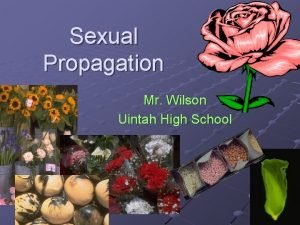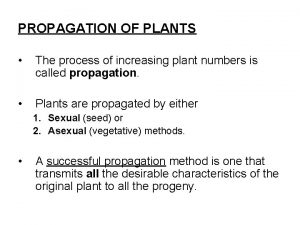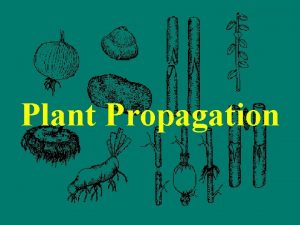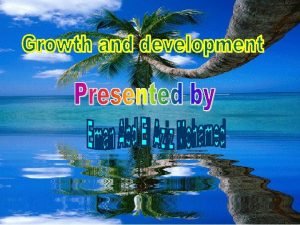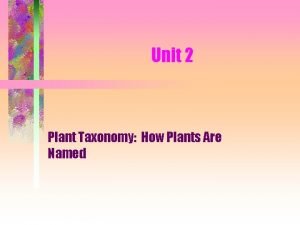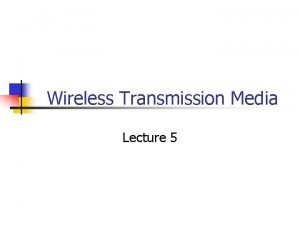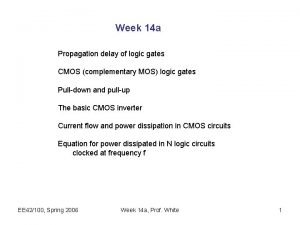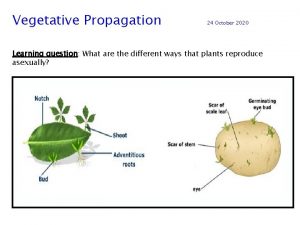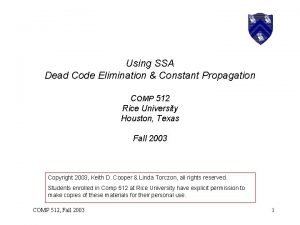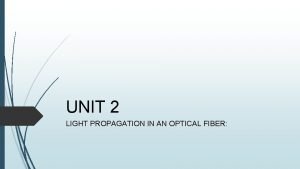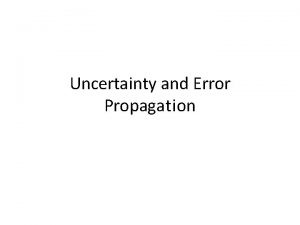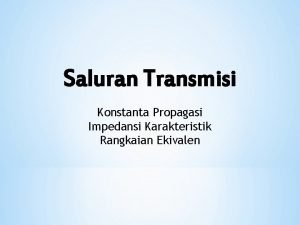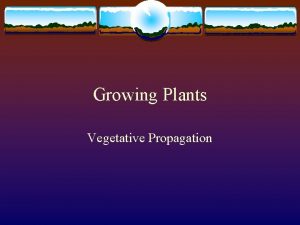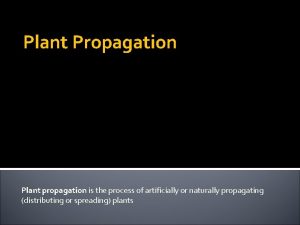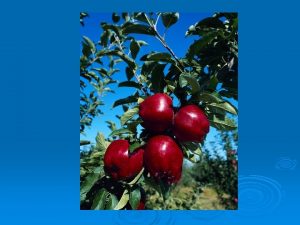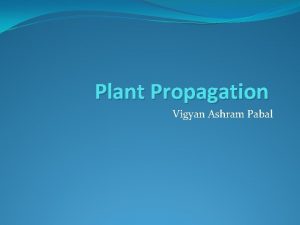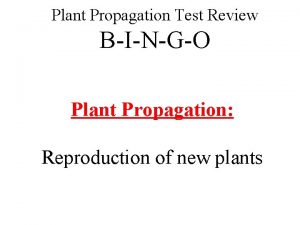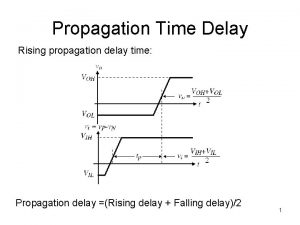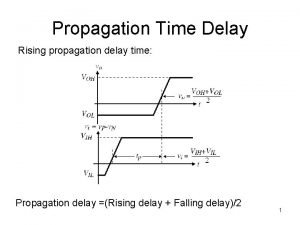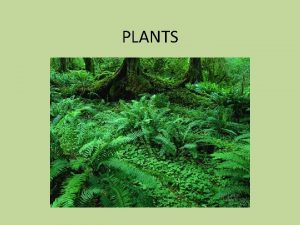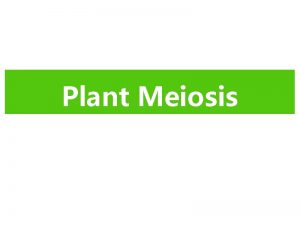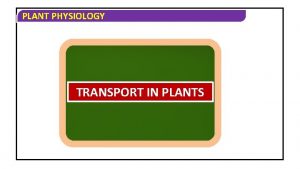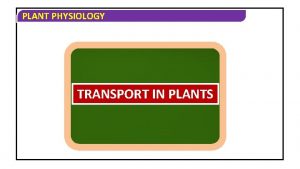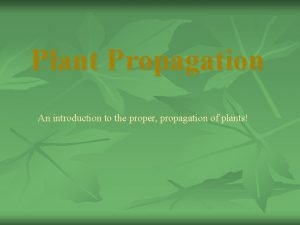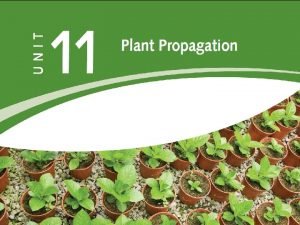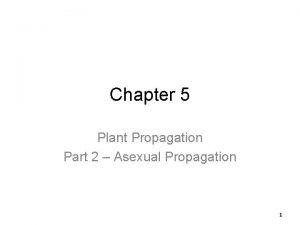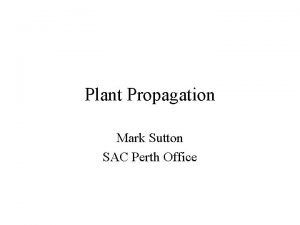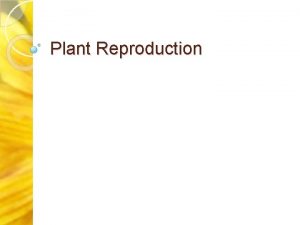PROPAGATION OF PLANTS The process of increasing plant

































































- Slides: 65

PROPAGATION OF PLANTS • The process of increasing plant numbers is called propagation. • Plants are propagated by either 1. Sexual (seed) or 2. Asexual (vegetative) methods. • A successful propagation method is one that transmits all the desirable characteristics of the original plant to all the progeny.

Ways of propagating plants: 1. Sexual (Propagation by seed) 2. • • • Asexual (vegetative) A. Apomictic embryos—citrus mango B. Cuttings—geraniums C. Grafting—dwarf fruit trees D. Budding E. Layering F. Runners—strawberry G. Suckers—red raspberry, blackberry H. Separation I. Division – 1. Stem tubers—white potato – 2. Tuberous roots—sweet potato, dahlia – 3. Rhizomes—iris, canna • J. Micropropagation—orchid, fern

Which method to use? Sexual or asexual? • If the plant group reproduces "true" by seeds— with no characteristics changed— the cultivar is termed a pure line. • A line is homozygous (Having similar alleles of a Mendelian pair present in the same cell as, for example, a dwarf pea plant with genes (tt) for dwarfness only) and, if self pollinated (or if cross pollination is prevented), seed propagation yields progeny like the original plant.

Examples: • Many of the world's leading economic plants— the cereals, the vegetables, and the garden flowers—are made up of groups of these lines. • On the other hand, many groups of plants are heterozygous (Having different allele of a Mendelian pair in the same cell as, for example, a tall pea plant with genes for tallness (T) and genes for dwarfness (t)) rather than homozygous. These include fruit and nut species, many forage crops, and woody ornamentals.

• heterozygous plants have many dissimilar genes that segregate and recombine so that the resulting plants differ from each other and from their parent. – With these plants, seed propagation cannot maintain the characteristics of the female parent and cannot be used as a successful propagation procedure. – With such heterozygous plants, vegetative (asexual) propagation is usually used. • Cultivars originating from a single plant or plant part and maintained in this manner by vegetative propagation are called clones.

SEXUAL PROPAGATION • In the sexual reproduction of plants, a seed must be produced in a flower. • Seed formation is preceded by a type of cell division termed meiosis, in which the number of chromosomes in the cells is reduced by half to form the male sperm cell and the female egg. The egg and sperm combine during fertilization in the ovule to form the zygote that develops into the embryo.

Seed Production • If a cultivar is homozygous and self pollinated, seed purity is generally assured. • If a cultivar is homozygous but cross pollinates with other cultivars or with other species, then the plants used to produce the seeds must be separated by con siderable distances from other plants with which they are likely to cross to prevent pollen contamination and loss of genetic purity.

Seed certification programs • Many countries have established seed certification programs to protect and maintain the genetic quality of cultivars. Seed certification programs usually recognize four classes of seeds in agronomic crops, such as cotton, alfalfa, soybeans, and cereal grains: • 1. Breeder seed. – Produced only in small amounts – Under the control of the plant breeder. – Planted to produce foundation seed. • 2. Foundation seed. – Available in limited amounts – Multiplied from breeder seed; – Planted to produce registered seed.

• 3. Registered seed. – The seed source for growers of certified seed – Under the control of the registered seed producers. – The progeny of either breeder or foundation seed. • 4. Certified seed. – Available in large quantities – Sold to farmers for general crop production. – Is of known genetic identity and purity. • The production of plants from hybrid seeds has been one of the outstanding scientific breakthroughs in agricultural history.

Seed Formation • A seed has three essential parts: 1. The embryo, which develops into the new plant. 2. Food storage material, which is available to nourish the embryonic plant. This may be either endosperm tissue or the fleshly cotyledon(s), part of the embryo itself. 3. Seed coverings, which are usually the two seed coats but may include other parts of the ovary wall. Coverings protect the seed and may help control seed dormancy.

• The parts of the seed as they develop from the parts of the flower are: Ovary fruit (sometimes composed of more than one ovary, plus additional tissues) Ovule seed (sometimes coalesces ﻣﻠﺘﺤﻢ with the fruit) Integuments seed coats (two) Nucellus perisperm (usually absent or reduced but sometimes develops into storage tissue) 2 polar nuclei + 1 sperm nucleus endosperm (triploid— 3 N) Egg nucleus + 1 sperm nucleus Embryo (diploid— 2 N)

Seed Storage and Viability Testing • For a seed to germinate, the embryo must be alive. • Embryo may stay alive for few days months (maple )ﻗﻴﻘﺐ or for many years (hard seeded legume). • The length of embryo viability often depending on seed storage conditions. For example, seeds stored in a sealed container under refrigeration at 0°C to 4°C and at low relative humidity generally retain via bility considerably longer than seeds sorted at room temper ature and high relative humidity.

• It is often advisable before planting seeds, especially those of woody perennials and those that may have been stored for several years, to test the viability of a representative sample of the seed lot to be planted. • One easy means of determining the possible germinability of a seed lot is 1. Cut test. 2. Float test 3. X ray photographs of seeds • These tests are not, strictly speaking, viability tests, they are useful to rule out seeds that have no possibility of germinating.

Germination Test • The germination test is useful for seeds that have no dormancy problems, such as flower, vegetable, and grain seed. • After several days or weeks, viability is calculated as the percentage of seedlings developing from the total number of seeds planted.

Tetrazolium Test • The chemical 2, 3, 5 triphenyl tetrazolium chloride, which colorless when dissolved in water, changes to the red color chemical, triphenyl formazan, whenever it contacts living respiring tissue. In living tissues, enzymes change the tetrazolium salt to formazan. • The embryo turns red, the seeds are viable; if the embryo remains white, the seeds are nonviable.

Excised Embryo Test • The embryos in the seeds of many woody plant species have profound dormancy conditions and do not respond in a direct germination test. • However, if the embryos is carefully excised from the seed and placed on moist paper in covered dish, viable embryos will show some activity.

Seed Dormancy • Seeds of many plant species, especially woody perennials, do not germinate when they are extracted from the mature fruit and planted, even though all temperature, light, and moisture conditions favor germination. • In nature, these dormancy factors prevent seed germination of woody perennials in the autumn, allowing the embryonic plant within the seed to overwinter in a very cold resistant form. • Seed dormancy can result from structural or physiological conditions in the seed coverings, particularly the seed coats, or in the embryo itself, or both. • Often, the causes for dormancy require specific treatments to overcome them before germination can take place.

Seed Coat Dormancy • Seed coats or other tissues covering the embryo may be impermeable to water and gases, particularly oxygen, which therefore cannot penetrate to the embryo and initiate the physiological processes of germination. • This situation usually occurs in species whose seeds have hard seed coats, such as alfalfa, clover, and other legumes. • In some species, the seed coats are apparently perme able to water and gases but have such high mechanical resistance to embryo expansion.

Artificial methods of softening seed coats are widely used to enhance germination: 1. Scarification The surface of the seed is mechanically scratched or ruptured. This is often done by rubbing the seed between sheets of sandpaper. 2. Heat treatment In many kinds of seed, exposure to heat, usually boiling water, for a short time. 3. Acid scarification Soaking seeds with impervious coverings ﺃﻐﻄﻴﺔ ﺣﺎﻣﻴﺔ in concentrated sulfuric acid for a proper length of time.

Embryo Dormancy • Embryo dormancy is very common in seeds of woody perennial plants. It is due to physiological conditions or germination blocks in the embryo itself • Stratification, in which boxes are filled with alternate layers of moist sand seed and set outdoors in a protected shady place to overwinter.

The critical conditions in seed stratification are: • • 1. Chilling temperatures. From about 1°C to 7°C. 2. Moisture. 3. Adequate oxygen. 4. Period of time. The optimum stratification time varies considerably among species. Seeds of the American plum (Prunus americand), for example, require at least ninety days chilling while, at the other extreme, apricot seeds (Prunus armeniaca) require only twenty to thirty days. • More precise stratification treatments can be given if controlled refrigeration is used.

Double Dormancy • Seeds of some species have both seed coat and embryo dormancy. An example is redbud (Cercis occidentalis).

Chemical inhibitors • In many species, the seeds contain one or more chemicals that can block essential steps in the germination process. • The inhibitor might be in – Endosperm tissue (iris seeds). – Seed coats – Pericarp (ovary wall). • Some of these germination inhibitors are well known chemicals such as coumarin and caffeic acid. • Seeds of certain fleshy fruits—tomatoes, lemons, strawberries—do not germinate while still attached to the fruit because of certain of these germination inhibitors in the fruits.

Secondary Dormancy • Seeds that are ready to germinate after all germination blocks are removed can become dormant again because of exposure to some environmental condition. • Example: Exposing winter barley or spring wheat seeds to certain unfavorable conditions, such as high temperatures or high moisture levels, can also induce a secondary dormant

Seed Germination • If the seeds have viable embryos, have all germination blocks removed, and are placed under proper environmental conditions of moisture, temperature, and (sometimes) light, the quiescent ﻫﺎﺩﺋﺔ embryos in the seeds can resume their growth. • Germination can proceed in several ways, depending on the species. – Sometimes the cotyledons are pushed above ground (epigeal germination) and – sometimes they remain below ground (hypogeal germination ).

The sequence of events during seed germination is as follows 1. Imbibition of water by the seeds. The cells become turgid and the seed coverings soften and rupture, permitting easy passage of oxygen and carbon dioxide. 2. Activation of hormones and enzymes. The enzymes convert complex food storage molecules into simpler food materials that can be readily translocated and used for growth. Other enzymes are involved in the respiratory processes, which release energy for cell division and growth. 3. Embryo growth and development. The root shoot axis (plumule, epicotyl, hypocotyl, and radicle) grows by cell division and enlargement.


Environmental Factors Influencing Seed Germination 1. Adequate moisture 2. Proper temperature 3. Good aeration 4. Light (in some cases) 5. Free from pathogenic organisms 6. Free from toxic amounts of salts

VEGETATIVE PROPAGATION • Vegetative or asexual propagation is accomplished entirely through mitosis, • The primary advantage of clones is the uniformity of the member plants. Each daughter cell is an exact replica of its mother cell. Chromosome numbers and composition do not change during cell division.

Mitotic cell division produces: (see Fig. 14 -9). • Adventitious shoots are those appearing any place on the plant other than from the shoot terminals or in the axils of leaves. • Adventitious roots appear any place on the plant other than from the radicle (root tip) of the seed or its branches. • Callus is a mass of undifferentiated and proliferating parenchyma cells.

• Vegetative propagation is used primarily for woody perennial plants that are highly heterozygous; that is, those that do not "breed true" from seed.

Cultivated clones originate in two ways: • The first, and usual, way is as seedling plants that some person recognizes as having some superior qualities and proceeds to propagate vegetatively. For example, the world famed Golden Delicious apple. • A second way clones originate is from mutations (bud sports). A single bud on a plant may have its genetic makeup altered during cell division so that, as the bud grows and develops into a branch, one or more of its characteristics differs from those of the rest of the plant. • For example: The desirable pink fleshed Ruby grapefruit originated in 1929 as a mutated branch on the Thompson Pink grapefruit, which in turn had originated in 1913 as a mutated branch on a white Marsh grapefruit tree.

Some mutation disadvantages: • Deterioration of the clone. • Chimeras, genetically change only a portion rather than the entire shoot.

Disease Problems in Clones • Clones can become infected with systemic viruses and mycoplasmalike organisms that are passed along to the daughter plants during asexual propagation procedures. • While, virus free seedlings can be obtained in many species by seed propagation because the virus is not transmitted through the embryo. Procedure to eliminate viruses from clones 1. Some viruses can be removed from clonal material by heat treatment at 37 38°C for 2 4 weeks or longer. 2. Shoot-tip culture. In virus infected plants, the terminal growing point is often free of the virus.

Apomixis • Apomixis is a form of asexual propagation because there is no union male and female gametes before seedling production. • There are several types but a common one is found in citrus seeds where, in addition to the sexual embryo formed through the usual pollination and fertilization processes, embryos also arise in the nucellar tissue. The nucellar tissue enclosing the embryo sac has not undergone meiosis and has the same genetic makeup as the female parent. • The nucellar embryos, although developing in a seed, are exactly the same genetically as the mother plant and thus maintain the clone. • Such seeds can contain several nucellar embryos in addition to the sexual embryo. Thus, several seedlings are obtained from one seed, a situation known as polyembryony.

Propagation by Cuttings • Cutting propagation is a vegetative method widely used for propagating herbaceous and woody ornamental plants and, to a much lesser extent, fruit species. • A cutting is essentially a piece of vegetative tissue that, when placed under the proper environmental conditions, regenerates the missing parts—roots, shoots, or both—and develops into a self sustaining plant.

Cuttings can be classified according to the part of the plant from which they are obtained (Figure 14 -13): • Stem cuttings already have terminal or axillary buds→ must produce a new advenitious roots. • Leaf cuttings have neither buds nor roots → must produce both advenitious shoot and root. • Leaf-bud cuttings have a bud at the base of the petiole → must produce a new advenitious roots. • Root cuttings→ must produce a new advenitious shoot.

Plant species and cultivars vary markedly in their ability to develop adventitious roots, some plant cuttings: 1. Root easily. 2. Root only if the influencing rooting factors are carefully observed. 3. Root has never been developed.

Origin of Adventitious Roots in Stem Cuttings – In stem cuttings of herbaceous plants, adventitious roots generally originate laterally and adjacent to the vascular bundles, whereas – In cuttings of woody perennials, the roots originate in the region of the vascular cambium, often in young phloem parenchyma. • In each case, the new roots are in a position to establish a vascular connection with the conducting tissues of the xylem and phloem in the cutting.

Factors Influencing the Rooting of Cuttings 1. Source of Cutting Material If the cutting material for woody plant species can be taken from the young, nonflowering plants only a few years away from a germinated seed, rooting will be much better than when the cuttings are taken from old mature flowering and fruiting plants.

2. Time of Year the Cutting Material Is Taken In woody perennial plants, cutting material can be taken at any time of the year: 1. 2. 3. Hardwood cuttings often root best if the material is gathered in late winter, Softwood cuttings usually root best if taken in the spring shortly after new shoot growth has attained a length of 10 to 15 cm. Semihardwood cuttings are best taken in midsummer after the spring flush growth has matured somewhat. Herbaceous cuttings can be easily rooted any time of the year, especially when succulent.

3. Etiolation (the growth of shoots in the absence of light or in low light, causing them to be abnormally elongated and colored yellow or white due to the absence of chlorophyll) It has long been known that stem tissue developing in complete darkness is more likely to initiate adventitious roots than tissue exposed to light. 4. Treatment of Cuttings with Auxins Auxin (indoleacetic acid [IAA], indolebutyric acid (IBA), and naphthaleneacetic acid (NAA)) stimulated the initiation of adventitious roots on stem cuttings.

5. Misting The primary purpose of misting is to 1. Prevent dehydrating by keeping relative humidity near 100 percent around the cutting. 2. Reduces transpirational loss of water by keeping the cutting cool.

6. Bottom Heat in the Cutting Beds To force rooting at the base of cuttings before shoot growth starts, it is advisable to maintain temperatures at the base of the cuttings at about 24°C or about 6°C higher than that at the tops of the cuttings, 18. 5°C.

Propagation by Grafting and Budding • Grafting and budding are vegetative methods used to 1. Propagate plants of a clone whose cuttings are difficult to root. 2. Make use of a particular root stock rather than having the plant on its own roots. Certain rootstocks are often utilized to – Obtain a dwarfed or invigorated plant or to – Give resistance to soil borne pests.

Grafting • Grafting can be defined as the art of joining parts of plants together so that they will unite and continue their growth as one plant. • The scion is that part of the graft combination that is to become the upper or top portion of the plant. – Usually the scion is a piece of stem tissue several inches long with two to four buds). – If this piece is reduced in size so there is just one bud, with a thin layer of bark and wood under it, then the operation is termed budding. • The rootstock is the lower part of the graft combination, the part that is to become the root system.

Grafting is used to 1. Change the fruiting cultivar in a fruit tree or grapevine to a different one (top-grafting). 2. Repair the damaged trunk of a tree (bridge grafting) 3. Replace an injured root system (inarching). 4. Study the transmission of viral diseases.

Standard methods of grafting and budding • Grafting Whip Grafting Cleft Grafting Bark Grafting • Budding T-budding Patch-Budding


Healing of the Graft and Bud Union 1. The cambial layers of rootstock and scion are brought into intimate contact. 2. They are held in place by wedging, nailing, or wrapping so that the parts cannot move about or become dislodged. 3. Then the graft union is thoroughly covered with plastic or cloth tape or, better, by grafting wax to keep out air. 4. The union heals by callus production from young tissues near the cambium layers of both rootstock and scion.

• Temperature levels must be conducive to cellular activity—generally from about 10°C to 30°C and no dry air must contact the cut surfaces because it would desiccate the tissues. • Healing usually takes about two weeks and must be completed, with vascular connections made for translocation of water through the xylem, before the buds on the scion start to grow and develop leaves.

Limits of Grafting • The partner (stock and scion) in the combination must have some degree of botanical relationship —the closer the better. For example: Case Rate of success Example Scion Rootstock Same family but different genera A few cases have completely successful Common sweet or ange (Citrus sinesis), a large evergreen tree Deciduous large shrub trifoliate orange (Poncirus trifoliatd) Same genus but different species Many such graft combinations will not unite Almonds (Prunus. dulcis), apricots (P. ar meniaca) Peach seedlings (P. persica) Different cultivars (clones) within a species Almost 100 percent that the graft combination will succeed Jonathan apple tree (Malus pumila) Any other apple cultivar, for example, the Golden Delicious (Malus pumila).

Graft incompatibility • Inompatibility in grafting is the failure of two different plants, grafted together, to produce a successful union and to develop satisfactorily into one composite plant. • The causes for graft incompatibility are little understood in spite of many years of research into the problem. There is some evidence, however, that in certain graft combinations one partner (scion or stock) produces chemicals that are toxic to the other, killing the entire plant.

Layering • Layering is similar to propagation by cuttings except that, instead of severing the part to be rooted from the mother plant, it is left attached and receives water and nutrients from the mother plant. • After the stem piece (layer) rooted it is cut from mother plant and transplanted to grow independently.

• Layering procedures: • • Tip Layering Simple Layering Mound Layering Air Layering

Other Plant Structures Providing Natural Propagation Methods • Runners – Some plants, such as the strawberry (Fig. 14 22), grow as a rosette crown (shoot root junction), with runners (stolons) arising from the crown. New plants arise from nodes at intervals along these runners. – The strawberry runner plants can be dug, packed in polyethylene lined boxes, and placed in cold storage ( 2°C) for planting later, usually the following spring.

• Suckers – Some plants, such as the blackberry and red raspberry, produce adventitious shoots—or suckers—from their horizontal root system. – These individual shoots with a piece of the old root attached can be dug and replanted. • Crowns – Many perennial plants exist as a single unit, becoming larger each year as new shoots arise from the crown of the plant. – Vegetative propagation of such plants consists of crown division— cutting the crown into pieces, each having roots and shoots, and transplanting to a new location (Fig. 14 23).

Propagation Using Specialized Stems and Roots • A number of herbaceous perennial plants have structures such as bulbs, corms, tuberous roots, or rhizomes. • These structures function as: • Food storage organs during the plant's annual dormant period and • Vegetative propagation structures. • In bulbs and corms, the newly formed plants break away from the mother plant naturally. This type of propagation is termed separation. • The remaining structures—tubers, tuberous roots, and rhizomes—must be cut apart; this is termed propagation by division.

MICROPROPAGATION (TISSUE CULTURE) • Micropropagation is defined as growing very small pieces of plant tissue on sterile nutrient media under aseptic conditions in small glass containers. These small pieces of tissue are called explants. • The explant may develop masses of callus by continuous cell division. From these callus clumps, roots and shoots may differentiate to form new plants.

Different parts of the plant can be taken as the explant. • • • Entire seeds Embryos Shoot tip A piece of stem/root/leaf tissue Pollen grains

BIOTECHNOLOGY • Biotechnology is the management of biological systems for the benefit of humanity. • New biotechnology developed advanced genetic engineering techniques. • Genetic engineering complements but does not replace traditional breeding techniques. • Because the genetic code is the same for all DNA carrying organisms, DNA from one organism can be utilized by another, even though the two organisms may be biologically very different. • Genetic engineering enabled plant scientists to introduce many plants with foreign DNA that gives resistance to insects, heribicides, certain environmental stresses, or other traits. Such organisms are commonly called genetically modified organisms (GMOs).

General Steps of most genetic engineering 1. The identification of a gene that imparts a desired trait 2. The gene is cut from the chro mosome of cells taken from the host organism. 3. If insufficient numbers of the gene can be extracted, the gene is amplified, meaning it is increased in great numbers, usually by a process called polymerase chain reaction (PCR). 4. The gene is then inserted either by a bacterium or gene gun into the nucleus of cells of the plant being transformed. 5. The plants that develop from these cells are tested to be sure they carry the gene. 6. Then through traditional breeding or asexual propagation, large numbers of the transformed plant are produced.

• Two of the most commonly found GMO crops are those designated as Bt® and Round Up Ready® – Bt® plants means the plant carries a gene from the Bacillus thuringenis bacterium. The generates a protein that is poisonous to some insects that feed on it. – Round-up Ready® plants are resistant to the herbicide, Round Up®. • By using Bt® and Round Up Ready® plants, farmers have been able to reduce the use of chemical pesticides and implement tilling practices that reduce soil erosion and improve soil quality.

• There is considerable resistance from the general public to buying and using products from the crops because there is fear that: 1. Bt® toxin would be poisonous to humans. 2. Round Up® resistance will be transferred by natural breeding to native weed species.

• A type of rice has been developed that carries the genetic information to produce beta-carotene in the rice grains. Beta carotene can help prevent blindness in children and reduce the incidence of childhood blindness in underdeveloped countries where rice is a dietary staple.
 Simple layering examples
Simple layering examples Advantages of plant propagation
Advantages of plant propagation Plant propagation algorithm
Plant propagation algorithm Development refers to
Development refers to Nonvascular plant
Nonvascular plant Non vascular plant reproduction
Non vascular plant reproduction Characteristics of non-flowering plants
Characteristics of non-flowering plants Photosynthesis equation
Photosynthesis equation Unit 2 plant taxonomy how plants are named
Unit 2 plant taxonomy how plants are named Define plant breeding
Define plant breeding Plant breeding for disease resistance
Plant breeding for disease resistance Plant introduction in plant breeding
Plant introduction in plant breeding Tronsmo plant pathology and plant diseases download
Tronsmo plant pathology and plant diseases download Tronsmo plant pathology and plant diseases download
Tronsmo plant pathology and plant diseases download Albugo eye
Albugo eye Hình ảnh bộ gõ cơ thể búng tay
Hình ảnh bộ gõ cơ thể búng tay Lp html
Lp html Bổ thể
Bổ thể Tỉ lệ cơ thể trẻ em
Tỉ lệ cơ thể trẻ em Gấu đi như thế nào
Gấu đi như thế nào Tư thế worms-breton
Tư thế worms-breton Bài hát chúa yêu trần thế alleluia
Bài hát chúa yêu trần thế alleluia Các môn thể thao bắt đầu bằng tiếng bóng
Các môn thể thao bắt đầu bằng tiếng bóng Thế nào là hệ số cao nhất
Thế nào là hệ số cao nhất Các châu lục và đại dương trên thế giới
Các châu lục và đại dương trên thế giới Công thức tiính động năng
Công thức tiính động năng Trời xanh đây là của chúng ta thể thơ
Trời xanh đây là của chúng ta thể thơ Mật thư anh em như thể tay chân
Mật thư anh em như thể tay chân 101012 bằng
101012 bằng Phản ứng thế ankan
Phản ứng thế ankan Các châu lục và đại dương trên thế giới
Các châu lục và đại dương trên thế giới Thơ thất ngôn tứ tuyệt đường luật
Thơ thất ngôn tứ tuyệt đường luật Quá trình desamine hóa có thể tạo ra
Quá trình desamine hóa có thể tạo ra Một số thể thơ truyền thống
Một số thể thơ truyền thống Bàn tay mà dây bẩn
Bàn tay mà dây bẩn Vẽ hình chiếu vuông góc của vật thể sau
Vẽ hình chiếu vuông góc của vật thể sau Biện pháp chống mỏi cơ
Biện pháp chống mỏi cơ đặc điểm cơ thể của người tối cổ
đặc điểm cơ thể của người tối cổ V cc
V cc Vẽ hình chiếu đứng bằng cạnh của vật thể
Vẽ hình chiếu đứng bằng cạnh của vật thể Vẽ hình chiếu vuông góc của vật thể sau
Vẽ hình chiếu vuông góc của vật thể sau Thẻ vin
Thẻ vin đại từ thay thế
đại từ thay thế điện thế nghỉ
điện thế nghỉ Tư thế ngồi viết
Tư thế ngồi viết Diễn thế sinh thái là
Diễn thế sinh thái là Dạng đột biến một nhiễm là
Dạng đột biến một nhiễm là Các số nguyên tố
Các số nguyên tố Tư thế ngồi viết
Tư thế ngồi viết Lời thề hippocrates
Lời thề hippocrates Thiếu nhi thế giới liên hoan
Thiếu nhi thế giới liên hoan ưu thế lai là gì
ưu thế lai là gì Sự nuôi và dạy con của hươu
Sự nuôi và dạy con của hươu Sự nuôi và dạy con của hươu
Sự nuôi và dạy con của hươu Sơ đồ cơ thể người
Sơ đồ cơ thể người Từ ngữ thể hiện lòng nhân hậu
Từ ngữ thể hiện lòng nhân hậu Thế nào là mạng điện lắp đặt kiểu nổi
Thế nào là mạng điện lắp đặt kiểu nổi Wireless transmission media
Wireless transmission media What is propagation delay in logic gates
What is propagation delay in logic gates Vegetative propagation mind map
Vegetative propagation mind map Sparse conditional constant propagation
Sparse conditional constant propagation The angle of acceptance cone is twice the *
The angle of acceptance cone is twice the * Error of propagation
Error of propagation Uncertainty when multiplying
Uncertainty when multiplying Sparse conditional constant propagation
Sparse conditional constant propagation Rumus impedansi karakteristik
Rumus impedansi karakteristik
